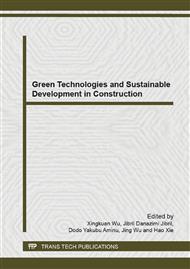p.293
p.297
p.302
p.307
p.312
p.316
p.320
p.323
p.329
An Integrated Energy Strategy for the Optimization of Retrofit Actions in Urban Planning
Abstract:
This research work aims at providing a methodology to analyze quantitatively energy sustainability of existing urban fabric and creating an urban energy system model as a decision support tool for the urban planning processes. Spatially resolved energy demand allows the identification of critical areas of energy consumption (CECA), in particular, a local-type spatial analysis has been adopted, GIS based, using a Kernel density estimation (KDE) and maps algebra. Within the CECA a simulation of energy consumption on an annual base for a representative building was carried out, in order to explore and estimate limits and vulnerabilities and to propose a hierarchy of energy-savings measures, addressing different scales of criticality in urban energy systems, from the city to district and block level.
Info:
Periodical:
Pages:
312-315
Citation:
Online since:
May 2014
Authors:
Keywords:
Price:
Сopyright:
© 2014 Trans Tech Publications Ltd. All Rights Reserved
Share:
Citation:


